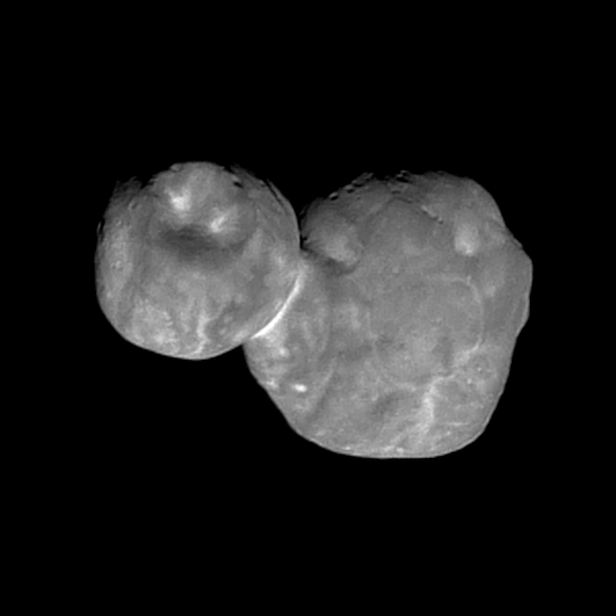New Horizons Update: Astronomers are starting to understand Ultima Thule’s secrets
The Kuiper Belt object has been critically analysed since its flyby at the beginning of 2019, and astronomers are slowly understanding its nature

The improved clarity of this image of Ultima Thule has amplified the graininess of the image when viewed at high contrast. Image credit: NASA/JHUAPL/SwRI
The farthest object ever explored is slowly revealing its secrets, as scientists piece together the puzzles of Ultima Thule – the Kuiper Belt object NASA’s New Horizons spacecraft flew past on New Year’s Day, 6.4 billion kilometres (four billion miles) from Earth.
Analysing the data New Horizons has been sending home since the flyby of Ultima Thule (officially named 2014 MU69), mission scientists are learning more about the development, geology and composition of this ancient relic of Solar System formation. The team discussed those findings today at the 50th Lunar and Planetary Science Conference in The Woodlands, Texas, United States.
Ultima Thule is the first unquestionably primordial contact binary ever explored. Approach pictures of Ultima Thule hinted at a strange, snowman-like shape for the binary, but further analysis of images, taken near closest approach – New Horizons came to within just 3,500 kilometres (2,200 miles) – have uncovered just how unusual the KBO’s shape really is. At 35 kilometres (22 miles) long, Ultima Thule consists of a large, flat lobe (nicknamed “Ultima”) connected to a smaller, rounder lobe (nicknamed “Thule”).
This strange shape is the biggest surprise, so far, of the flyby. “We’ve never seen anything like this anywhere in the Solar System,” says New Horizons Principal Investigator Alan Stern, of the Southwest Research Institute, Boulder, Colorado, United States. “It is sending the planetary science community back to the drawing board to understand how planetesimals – the building blocks of the planets – form.”
Because it is so well preserved, Ultima Thule is offering our clearest look back to the era of planetesimal accretion and the earliest stages of planetary formation. Apparently Ultima Thule’s two lobes once orbited each other, like many so-called binary worlds in the Kuiper Belt, until something brought them together in a “gentle” merger.
“This fits with general ideas of the beginning of our Solar System,” says William McKinnon, a New Horizons co-investigator from Washington University in St. Louis, United States. “Much of the orbital momentum of the Ultima Thule binary must have been drained away for them to come together like this. But we don’t know yet what processes were most important in making that happen.”
That merger may have left its mark on the surface. The “neck” connecting Ultima and Thule is reworked, and could indicate shearing as the lobes combined, said Kirby Runyon, a New Horizons science team member from the Johns Hopkins Applied Physics Laboratory in Laurel, Maryland, United States.
Runyon and fellow team geologists are describing and trying to understand Ultima Thule’s many surface features, from bright spots and patches, to hills and troughs, to craters and pits. The craters, while at first glance look like impact craters, could have other origins. Some may be pit craters, where material drains into underground cracks, or a result of sublimation, where ice went directly from solid to gas and left pits in its place. The largest depression is a eight-kilometre-wide (five-mile-wide) feature the team has nicknamed Maryland crater. It could be an impact crater, or it could have formed in one of the other above-mentioned ways.
“We have our work cut out to understand Ultima Thule’s geology, that is for sure,” Runyon says.
In colour and composition, New Horizons data revealed that Ultima Thule resembles many other objects found in its region of the Kuiper Belt. Consistent with pre-flyby observations from the Hubble Telescope, Ultima Thule is very red – redder even than Pluto, which New Horizons flew past on the inner edge of the Kuiper Belt in 2015 – and about the same colour as many other so-called “cold classical” KBOs. (“Cold” referring not to temperature but to the circular, uninclined orbits of these objects; “classical” in that their orbits have changed little since forming, and represent a sample of the primordial Kuiper Belt.)
“This is the first time one of these ‘ultra red’ objects has been explored, and our observations open all kinds of new questions,” says Carly Howett, a New Horizons science team member from SwRI. “The colour imaging even reveals subtle differences in colouration across the surface, and we really want to know why.”
New Horizons scientists have also seen evidence for methanol, water ice and organic molecules on the surface. “The spectrum of Ultima Thule is similar to some of the most extreme objects we’ve seen in the outer Solar System,” says Silvia Protopapa, a New Horizons co-investigator from SwRI. “So New Horizons is giving us an incredible opportunity to study one of these bodies up close.”
The Ultima Thule data transmission continues, though all of the data from the flyby won’t be on the ground until late summer 2020. In the meantime, New Horizons continues to carry out distant observations of additional Kuiper Belt objects and mapping the charged-particle radiation and dust environment in the Kuiper Belt.
The New Horizons spacecraft is 6.6 billion kilometres (4.1 billion miles) from Earth, operating normally and speeding deeper into the Kuiper Belt at nearly 53,000 kilometres (33,000 miles) per hour.
Keep up to date with the latest news in All About Space – available every month for just £4.99. Alternatively you can subscribe here for a fraction of the price!




